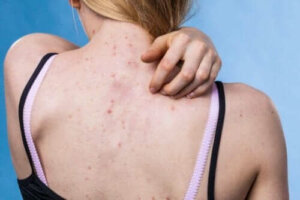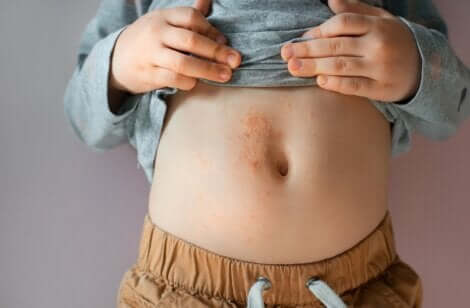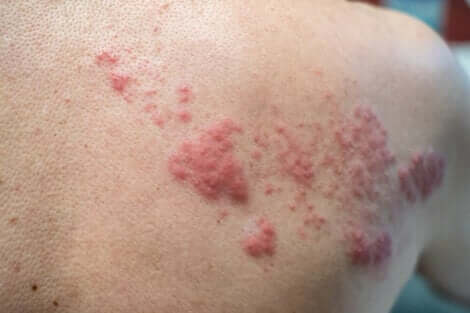10 Causes and Types of Skin Rashes


Written and verified by the dermatologist Maria del Carmen Hernandez
There are many different types of skin rashes. However, they all cause inflammation and irritation. Some aren’t contagious, but they all may cause embarrassment or discomfort in those who suffer from them.
As they manifest in different ways, they also have various causes. Therefore, they develop with different signs and symptoms and require different treatments.
How can you differentiate between them? Below, we’ll tell you about their main characteristics.
Main types of skin rashes
Many different factors, including heat, infections, allergens, medications, and immune system disorders, can cause skin rashes. Therefore, to get adequate diagnosis and treatment, you need to consult a specialist.
After examining you, the medical professional may indicate the use of medicated shampoos, creams, ointments, or other types of products to control your symptoms.
So, what are the most common types of skin rashes?
1. Atopic dermatitis
First, one of the most common types of skin rashes is atopic dermatitis. This condition manifests itself with intermittent flare-ups that come and go.
Often, it causes intense itching and redness. In fact, according to the phase, it’s in, it can cause red plaques, marked skin folds and peeling.
Unfortunately, experts still don’t know what causes this skin condition. However, a study that was published in the International Journal of Health Sciences states that it’s more common in people with a family history of seasonal allergies and genetic predisposition or asthma. Also, environmental and dietary factors play a role.

2. Skin rashes: Psoriasis
Next, psoriasis is a chronic inflammatory skin disease with a strong genetic predisposition and autoimmune pathogenic traits. According to studies by the International Journal of Molecular Sciences, the global prevalence is approximately 2%. However, it varies according to region.
Overall, the dermatological manifestations of psoriasis are varied. It may cause itchy, erythematous, and delimited plaques covered with scales. The plaques can merge and cover large areas of the skin.
Typically, it affects the following areas:
- Trunk
- Scalp
- Extensor surfaces of the limbs
This article may interest you: Scalp Psoriasis: Symptoms and Treatment
3. Contact dermatitis
Direct contact with allergens causes allergic contact dermatitis. Often, only the area that came into contact with the allergen is affected. Common allergens include perfumes, costume jewelry, hair dyes, and cosmetic products.
Overall, the following are the most common symptoms:
- Skin rash
- Swelling and itching
- Fluid discharge, blisters, and scabs
4. Tinea versicolor
Next, tinea versicolor is a skin pigmentation disorder a lipophilic fungus called Malassezia spp causes. It’s a superficial mycosis characterized by well-defined skin lesions that are slightly scaly and vary in color.
Studies conducted by the Brazilian Society of Dermatology concluded that there’s a higher prevalence in young people in puberty, with a majority being women. Hypochromic skin lesions are the most common and predominate in the upper body.
5. Skin rashes: Seborrheic dermatitis
Seborrheic dermatitis is one of the most common types of skin rashes. It’s caused by inflammation of the most superficial skin layers. It commonly affects areas with many sebaceous glands.
Experts don’t know what causes it. However, a P&T publication states that it may be associated with the presence of the Malassezia fungus. Obesity, extreme climates, neurological disorders, and stress are risk factors.
Overall, the symptoms it causes include the following:
- Red skin
- Also, yellow crusts or scales on the face, ears, scalp, or other body parts
- Itching and resistant dandruff
Read on to learn more: The Differences between Atopic and Seborrheic Dermatitis
6. Herpes zoster
Herpes zoster is also known as “shingles”. This is a viral disease caused by the reactivation of the varicella-zoster virus that remains latent in the sensory nerve ganglia after a previous chickenpox infection.
The virus causes local inflammation and blisters on the skin. The pain this condition causes is due to the inflammation of the nerves affected by the virus.
Overall, some of the triggers of shingles include:
- Firstly, stress.
- Use of immunosuppressive drugs.
- Also, acute or chronic diseases.
- Presence of a malignancy.
- Exposure to the virus.
- Finally, herpes zoster.

7. Skin rashes: Dermatophytosis
Next, dermatophytosis is also known as “ringworm”. This infection is caused by fungi, which can affect the skin and nails. Symptoms and signs of ringworms include peeling, itching, and skin rashes.
Typically, it affects the following areas:
- Scalp
- Feet
- Groin
- Beard area
However, different types of dermatophytes cause different conditions. Thus, the location of the injury determines the classification and type of fungus that caused it.
8. Rosacea
Rosacea is a chronic inflammatory skin disease that most commonly affects the face, as it’s one of the most visible skin areas. It causes redness, pimples, pustules, and dilated blood vessels.
It often affects the eyes. Also, in some people, it can cause a red, enlarged nose, a condition known as rhinophyma. Dermatology Reports concluded in a review that 15-40% of patients have a family history of the condition.
9. Pityriasis rosea
Next, pityriasis rosea is an acute papulosquamous disorder that resolves on its own. It causes a herald patch followed by scaly oval patches on the trunk and proximal limbs with a characteristic “christmas-tree” distribution.
Its exact cause is unknown. However, the upper respiratory tract infections that precede it suggest that Streptococcus plays a role. It affects people of both sexes, with an approximate incidence of 0.5 to 2%. The skin rash usually lasts six to eights weeks from the initial herald patch.
10. Scabies
Finally, scabies is a skin infection caused by the mite Sarcoptes scabiei. It causes a skin rash characterized by intense itching, predominantly nocturnal, tiny burrows the parasite makes, and secondary skin lesions.
Its transmission is by direct contact where the mite remains viable between two and five days. Ten minutes of skin-to-skin contact is required for the mites to spread to another host.
This condition was declared a neglected skin disease by the World Health Organization (WHO) in 2009 and is a major health problem in many developing countries.
What to do if you suffer from skin rashes
Overall, there’s a specific treatment for each of these types of skin rashes. Therefore, if you’re suffering from any of these symptoms, it’s best to see a dermatologist. There, they’ll help you discover your treatment options according to your clinical picture.
In turn, your doctor will tell you what you’ll need to do to keep the discomfort under control. In some cases, the use of topical products will be enough. Meanwhile, in other cases, patients may need to resort to drugs and other interventions.
All cited sources were thoroughly reviewed by our team to ensure their quality, reliability, currency, and validity. The bibliography of this article was considered reliable and of academic or scientific accuracy.
- Rendon A, Schäkel K. Patogénesis y tratamiento de la psoriasis. Int J Mol Sci . 2019; 20 (6): 1475. Publicado el 23 de marzo de 2019. doi: 10.3390 / ijms20061475
- Kolb L, Ferrer-Bruker SJ. Atopic Dermatitis. [Updated 2020 May 3]. In: StatPearls [Internet]. Treasure Island (FL): StatPearls Publishing; 2020 Jan-
- Al-Shobaili HA, Ahmed AA, Alnomair N, Alobead ZA, Rasheed Z. Molecular Genetic of Atopic dermatitis: An Update. Int J Health Sci (Qassim). 2016;10(1):96-120.
- Murphy PB, Hooten JN, Atwater AR, et al. Allergic Contact Dermatitis. [Updated 2020 May 13]. In: StatPearls [Internet]. Treasure Island (FL): StatPearls Publishing; 2020 Jan
- Berk T, Scheinfeld N. Seborrheic dermatitis. P T. 2010;35(6):348-352.
- Gupta AK, Bluhm R, Summerbell R. Pityriasis versicolor. J Eur Acad Dermatol Venereol. 2002;16(1):19-33. doi:10.1046/j.1468-3083.2002.00378.x.
- Santana JO, Azevedo FL, Campos Filho PC. Pitiriasis versicolor: caracterización clínico-epidemiológica de pacientes en el área urbana de Buerarema-BA, Brasil. Un Dermatol Bras . 2013; 88 (2): 216-221. doi: 10.1590 / S0365-05962013000200005
- Nair PA, Patel BC. Herpes Zoster (Shingles) [Updated 2020 Jun 23]. In: StatPearls [Internet]. Treasure Island (FL): StatPearls Publishing; 2020 Jan
- Tainwala R, Sharma Y. Pathogenesis of dermatophytoses. Indian J Dermatol. 2011;56(3):259-261. doi:10.4103/0019-5154.82476
- Mikkelsen CS, Holmgren HR, Kjellman P, et al. Rosacea: a Clinical Review. Dermatol Reports. 2016;8(1):6387. Published 2016 Jun 23. doi:10.4081/dr.2016.6387
- Litchman G, Nair PA, Le JK. Pityriasis Rosea. [Updated 2020 Jun 28]. In: StatPearls [Internet]. Treasure Island (FL): StatPearls Publishing; 2020
- Gilson RL, Crane JS. Scabies (Sarcoptes Scabiei) [Updated 2020 Jul 2]. In: StatPearls [Internet]. Treasure Island (FL): StatPearls Publishing; 2020
This text is provided for informational purposes only and does not replace consultation with a professional. If in doubt, consult your specialist.








